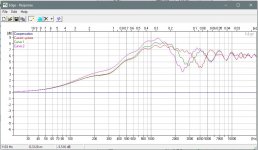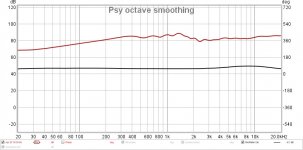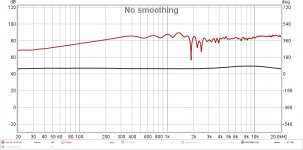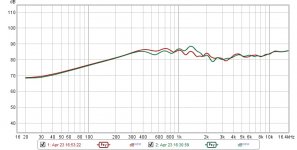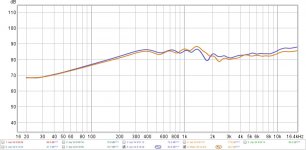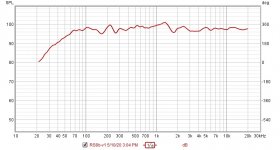Something is not right there. There is no baffle step loss.
The Edge makes no assumptions about a driver's FR at all. It only looks at the effects of the baffle. You then add that to the driver's FR, whatever it happens to be. The thing you are trying to do is find the right combination of driver and baffle response that will produce the flattest summed response. For this reason, I prefer to work with Response Modeler because it allows you to import the driver FR and then will sum it with the diffraction effects as you work on them. Needs Excel though and may still have problems with newer computers and Office versions. Otherwise, identify where you need to make compensations in the FR and then move the driver around on the baffle to make it happen. Change the baffle width as well if it suits your design goals.
The CD1 uses an 8mm x 38mm ribbon. Below is an example of what you should be seeing with the Edge. It shows 3 different positions of the driver on an 8" x 16" baffle.
The Edge makes no assumptions about a driver's FR at all. It only looks at the effects of the baffle. You then add that to the driver's FR, whatever it happens to be. The thing you are trying to do is find the right combination of driver and baffle response that will produce the flattest summed response. For this reason, I prefer to work with Response Modeler because it allows you to import the driver FR and then will sum it with the diffraction effects as you work on them. Needs Excel though and may still have problems with newer computers and Office versions. Otherwise, identify where you need to make compensations in the FR and then move the driver around on the baffle to make it happen. Change the baffle width as well if it suits your design goals.
The CD1 uses an 8mm x 38mm ribbon. Below is an example of what you should be seeing with the Edge. It shows 3 different positions of the driver on an 8" x 16" baffle.
Attachments
Does Edge allow for non rectangular baffles? I always found BDS to be the best (though certainly the hardest to use). Requires excell.
Baffle Diffraction Simulator
Tony.
Baffle Diffraction Simulator
Tony.
Does Edge allow for non rectangular baffles? I always found BDS to be the best (though certainly the hardest to use). Requires excell.
Baffle Diffraction Simulator
Tony.
Yes - it allows for multi-corner / odd shaped baffles. It also allows you to position the mic relative to X/Y and distance (Z) offset from the driver... so you can factor the off-axis rolloff. My version of edge however does not allow for chamfering or roundover of prescribed radius. maybe later versions do. I think you can also add in boundary re-inforcement. I haven't played around with this though.
Ok it must have been updated since I looked at it. My recollection was that it was very basic! 🙂
Tony.
Tony.
It used to be the bees knees. It had a plot in the corner showing time delay versus angle, which was a design trend at the time.
Just for fun I built the XO from post 1. Only change from the XO is I inverted the tweeter. This is how it measured 5ms gated and pyschoacoustic smoothed and 5ms gated no smoothing. In my office which is a nightmare at 26 inches.
Attachments
Here is a better measurements with a better scale. Green is the same as post 46 and red is with a random piece of card board tape to the baffle. I adds 2 inches above the tweeter and 6 inches to the left of the tweeter and roughly 4 inches to the lest of the 3/4 of the mid.
Attachments
Well that really demonstrates that changing the baffle shape in a random way changed the response, and in general, improved the response. I would have thought that any trapazoidal baffle would be pretty good... my criticism of trapezoidal shapes is that they are only slightly better than rectangular, but a lot harder to build...
But you seem to have discovered a trapezoid that is just plain bad.
But you seem to have discovered a trapezoid that is just plain bad.
More tweaks, I found the two pieces I had cut off to make the trapezoidal baffle and taped them back on. I also removed the series resistor in the tweeter circuit and switched to an Lpad, I think the series resistor was messing with my HP filter. Purple is the new measurement and tan is from yesterday.
Attachments
It has been a while, I'm just about finished just need to veneer, finish and make some grills. I ended up building what are pretty much old school 3 way bookshelves. I wish the trapezoidal enclosures worked, but sound quality trumps style. They sound good to me, but as always I'm biased. Here is a photo and a measurement I did outside. I think the bump and valley around 2k is mostly diffraction because it shows when I measure the mid by itself, not much I can do about it.
Attachments
 yes a hump around 1Khz and dip around 2Khz is likely baffle related, it corresponds fairly well to what you can see in Jreave's edge sim.
yes a hump around 1Khz and dip around 2Khz is likely baffle related, it corresponds fairly well to what you can see in Jreave's edge sim. Tony.
- Home
- Loudspeakers
- Multi-Way
- Anybody want to help with this 3 way crossover?
